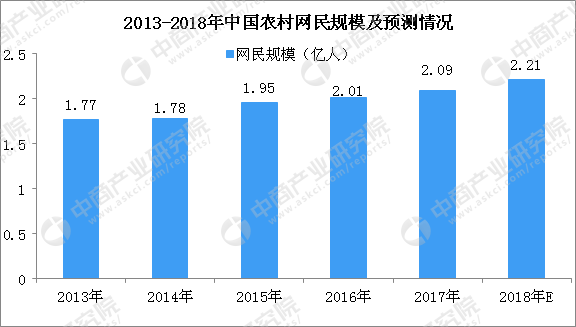What is the number of Chinese Internet users in 2018? According to the "China Internet Development Report 2018" (hereinafter referred to as the "Report") officially released by the Internet Society of China, as of the end of 2017, the number of Chinese Internet users reached 772 million.
As of the end of 2017, the number of web pages in China totaled 260.4 billion, with an annual growth rate of 10.3%, and the number of websites reached 5.33 million. Among them, the number of websites under the ".CN" domain name was 3.15 million, accounting for 59% of the total, with an annual growth rate of 21.8 %. In addition, the total number of IPv6 addresses allocated is 23430, accounting for 10.38% of the total number of allocated IPv6 addresses in the world, ranking second in the world.

Nearly half of users use mobile social software more than 3 times a day
According to the report, by the end of 2017, the number of Internet users in China reached 772 million, with a penetration rate of 55.8%, which is 40.74 million new Internet users compared to 2016. The average weekly online time per person is 27 hours. Among them, the number of Chinese mobile phone netizens increased by 57.34 million, reaching 753 million.
At the same time, webcast users continue to increase. The report shows that in 2017, the number of live broadcast users in China reached 398 million, and the number of users is expected to exceed 500 million in 2019. However, the growth rate of users in the live broadcast industry slowed down significantly last year, with a growth rate of 28.4%. It is expected that the growth rate will further slow to 10.2% in 2019.
The report also mentioned that as of the end of last year, there were about 200 companies in China that had launched or engaged in webcasting business, a decrease of nearly 100 companies compared with 2016, and a decrease of 400 companies compared with 2011. According to the analysis of the report, the flow bonus period of the self-media industry is coming to an end, and the development has ushered in a turning point. Among the major We-media platforms in 2017, the WeChat official account ranked first with a market share of 63.4%.
The report shows that mobile social software has become an essential tool for netizens’ mobile phones. Nearly half of users use mobile social applications three times a day, and more than 80% of users use mobile social applications for more than one hour a day.
In 2017, the average weekly online time of Chinese netizens was 27 hours, and mobile phones became the most important mobile Internet device. According to the report data, the proportion of mobile Internet users increased from 95.1% in 2016 to 97.5% in 2017.
The top three social applications with the highest user usage rate are WeChat Moments, Qzone and Sina Weibo, with usage rates reaching 87.3%, 64.4% and 40.9% respectively.
In the longer term, the average daily effective use time of China's mobile social apps has increased from 409,000 minutes in June 2016 to 492,000 minutes in May 2017. There has been an increase or decrease during this period, and the overall trend is spiraling.
In terms of online shopping, the transaction scale of China's online shopping market reached 7.18 trillion yuan last year, a year-on-year increase of 32.2%. The market growth rate once again ushered in an inflection point to further climb.
In terms of online payment, as of the end of last year, the number of online payment users in China reached 531 million, an increase of 56.61 million from the end of 2016, with an annual growth rate of 11.9%. Among them, the number of mobile payment users has grown rapidly, reaching 527 million, an increase of 57.83 million from the end of 2016, with an annual growth rate of 12.3%.
In 2017, third-party Internet payment reached 143.26 trillion yuan, the online shopping market transaction scale reached 5.33 trillion yuan, and the online retail market transaction scale was 7.18 trillion yuan.
The scale of online car-hailing users increased by nearly 20%
In terms of online travel, the report shows that as of the end of 2017, the total number of online car-hailing users in China, including online taxis and private express trains, reached 435 million, with a growth rate of 19.2%, basically remaining stable.
Specifically, the number of online taxi-hailing users reached 287 million, an increase of 61.88 million from 2016, with a growth rate of 27.5%; the number of online taxi-hailing users reached 236 million, an increase of 68.44 million from 2016, with a growth rate of 40.6%.
In the past two years, car-sharing services have been launched in many cities across the country and have become increasingly popular among consumers. The report shows that China's shared car market reached 790 million yuan in 2017, an increase of 83.7% year-on-year. It is expected that the market size will reach 2.15 billion yuan this year, and the growth rate will far exceed 2017. The shared car market will usher in a period of accelerated market expansion.
A few days ago, some media reported that the service of placing orders on mobile phones to make appointments for "shared nurses" appeared in many places across the country, arousing social concern. The report also shows that the number of users of online health services in China increased considerably in 2017.
According to statistics, the number of Internet medical users in China reached 253 million last year, an annual increase of 29.7%, and the utilization rate of Internet users was about 32.7%. The report predicts that the compound annual growth rate of China's Internet healthcare will reach 55.01% in the next few years, and the scale of China's mobile healthcare market will reach 69.74 billion yuan in 2021.
Specifically, among the types of apps that can be downloaded for free for medical and health consultation services, the "appointment registration" application is the most, followed by "sports and fitness", "personal health management", "online consultation" and "medical e-commerce"; paid; Among the downloaded apps, the category of "Popularization of Medical Pathology Knowledge" is the most popular, followed by "Sports Fitness", "Personal Health Management" and "Physical Sign Measurement".
China's rural netizens will reach 221 million in 2018At the first Digital China Construction Summit opened on April 22, 2018, the Ministry of Agriculture and Rural Affairs issued the "Development Prospects and Policy Orientation of Agricultural and Rural Informatization". According to relevant data, by the end of 2017, Internet users in rural areas of my country will use mobile phones to pay for offline consumption. The proportion has increased to 47.1%. According to statistics, by the end of 2017, rural netizens accounted for 27% of my country's netizens, the number of rural netizens reached 209 million, and the rural Internet penetration rate rose to 35.4%. According to the China Commercial Industry Research Institute, the number of Chinese rural Internet users will reach 221 million in 2018.

Data source: Compiled by China Commercial Industry Research Institute
Ningbo Xingchuangzhi Electric Appliance Co.,Ltd. , https://www.xingchuangzhi.com